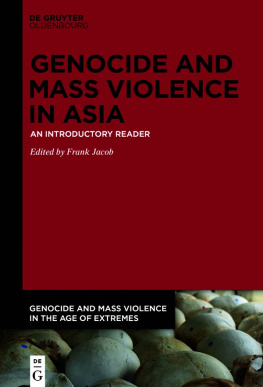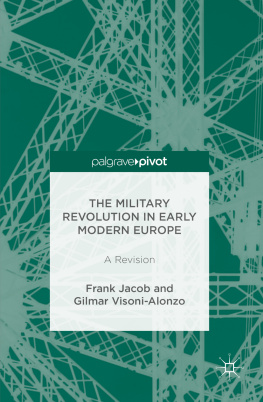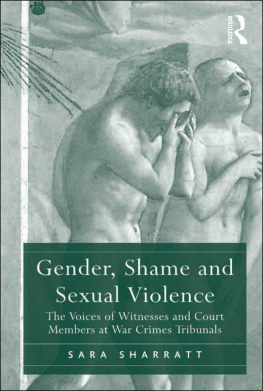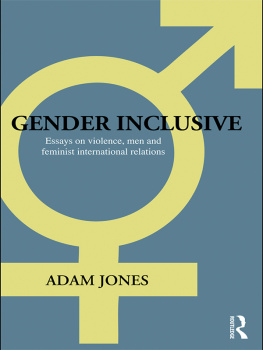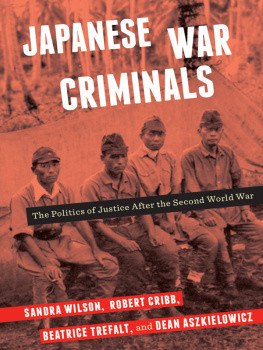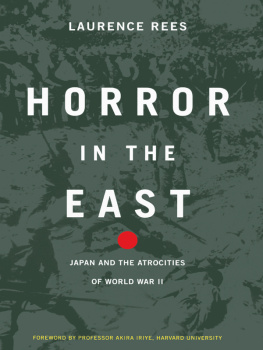Japanese War Crimes during World War II
Atrocity and the Psychology of Collective Violence
Frank Jacob

Copyright 2018 by Frank Jacob
All rights reserved. No part of this publication may be reproduced, stored in a retrieval system, or transmitted, in any form or by any means, electronic, mechanical, photocopying, recording, or otherwise, except for the inclusion of brief quotations in a review, without prior permission in writing from the publisher.
Library of Congress Cataloging-in-Publication Dat a
Names: Jacob, Frank, author.
Title: Japanese war crimes during World War II : atrocity and the psychology of collective violence / Frank Jacob.
Description: Santa Barbara, California : Praeger, 2018. | Includes bibliographical references and index.
Identifiers: LCCN 2018005505 (print) | LCCN 2018019849 (ebook) | ISBN 9781440844508 (ebook) | ISBN 9781440844492 (hardcopy)
Subjects: LCSH: War crimesJapanHistory20th century. | World War, 19391945AtrocitiesAsia. | Sino-Japanese War, 19371945Atrocities. | JapanArmed ForcesHistory20th century. | Collective behaviorCase studies. | WarMoral and ethical aspectsCase studies.
Classification: LCC D804.J3 (ebook) | LCC D804.J3 J33 2018 (print) | DDC 940.54/050952dc23
LC record available at https://lccn.loc.gov/2018005505
ISBN: 978-1-4408-4449-2 (print)
978-1-4408-4450-8 (ebook)
22 21 20 19 18 1 2 3 4 5
This book is also available as an eBook.
Praeger
An Imprint of ABC-CLIO, LLC
ABC-CLIO, LLC
130 Cremona Drive, P.O. Box 1911
Santa Barbara, California 93116-1911
www.abc-clio.com
This book is printed on acid-free paper 
Manufactured in the United States of America
Contents
Introduction
The late Iris Chang (19682004) wrote an important book, yet not a good one.
Nanjing was not Auschwitz. However, Jrgen Habermas emphasized that Auschwitz has changed the basis for the continuity of the conditions of life within history,
Although Chang was partially right regarding the Japanese denial faction, which continues to doubt the legitimacy of the anti-Japanese claims,
Naturally, one would argue that such acts are war crimes. However, to quote historian Daqing Yang, what is considered a war crimea prosecutable war crime, in particularis as much a political issue as a legal one. explains the anger about the lack of interest that Chang expressed in her book. U.S. military historian Edward J. Drea emphasized that
Changs moving testament to the Chinese victims of the sack of Nanjing in 1937 graphically detailed the horror and scope of the crime and indicted the Japanese government and people for their collective amnesia about the wartime armys atrocious conduct. The bestselling book spurred a tremendous amount of renewed interest in Japanese wartime conduct in China, Korea, the Philippines, Southeast Asia, and the Pacific.
It is also important to consider that the U.S. public had been informed about the atrocities in China early on when reports about the rape, killings, and executions of unarmed Chinese soldiers appeared in American newspapers and when returning missionaries and other eyewitnesses reported their experiences in the war zone.
However, the events faded away from public view, and something specific caused Japans lack of interest in critically dealing with its own past; in contrast to Germany, whose authorities took responsibility to express guilt for its crimes against peace and humanity between 1933 and 1945, the Japanese government rejected and downplayed such a responsibility. Considering the number of atrocities committed by the Japanese Imperial Army between 1931 and 1945, far too few people were tried after the war, and the longer it took to arouse public interest in the crimes, the easier it was for those guilty of murder, rape, and torture to disappear forever to lead a normal life. Additionally, most of them got away because documents that could have proven their guilt were destroyed before U.S. forces could reach Japanese soil.
From when a ceasefire was announced on August 15, 1945, until August 28, 1945when the first American troops arrived in Japanthe Japanese military and civil authorities invested a large amount of work in destroying compromising archival materials, especially those related to the war years between 1942 and 1945. Field units were ordered to burn materials that would have provided evidence of violence and torture against POWs, among other things. It is estimated that 70 percent of the existing sources were destroyed in these two weeks, the remaining ones provide a glimpse of the cruelties that dominated the war in the Pacific and Southeast Asia. Once the Allied Powers had concluded the trials, interest in Japanese war crimes faded quickly, as the Cold War demanded new allies in the region against the Soviet Union and the Peoples Republic of China. Because Japan became important again, the harsh prosecution of war criminals might have complicated the new alliance against communism.
In Japan itself, the situation remained dominated by right-wing powers. When in 1957 a group of returning veterans, who had spent years in a Chinese prison, published their own first-person accounts of war crimes
Works published on Japanese war crimes usually tend to cover four specific areas:
- Japanese war crimes in general
- Violence and torture against POWs and civilian work forces
- The Japanese biological warfare program known as Unit 731
- Forced prostitution and the so-called comfort women system
Single events, such as the massacre of 100,000 Filipinos during the Battle of Manila in early 1945, have also attracted interest.
The treatment of POWs by the Japanese soldiers was extreme and surprising to many, because Japan was considered to have set an example of how to treat POWs, especially during the first conflicts of the 20th century such as the Russo-Japanese War (19041905) and the First World War (19141918).
American scholar Ustinia Dolgopol was right when she emphasized that [t]he history of the comfort women is the story of voices being denied and suppressed, To achieve such a decision, the research results related to Japanese war crimes would have to be broadly communicated within Japans society, an approach that is regularly sabotaged by revisionist interest groups, and Japanese scholars who are truly interested in shedding light on the cruelties of the past are sometimes better known outside Japan than in their home country.
The situation is also complicated by the fact that the victim narrative is affected by existing nationalism in countries where survivors tend to be politically instrumentalized. Herein lies another problem: many of the perpetrators remain anonymous and will probably never be brought to justice. It thus seems more important to understand how it became possible for ordinary men to be so violent against women forced into sex slavery, POWs, and civilians.
Within a specific space-time continuum, however, violence can also take a form that is no longer bound by existing law and order and thus become indefinite. The possibility of otherwise criminal acts having no punishment in war creates a new space-time continuum that imposes no limitations on the violence used within it. Consequently, war also creates specific group identities: soldiers, men, Japanese people, etc. Such group identities are often dichotomous among existing enemy groups and often seek to violently extinguish each other.
Of course, we must accept that no theoretical approach toward violence can explain its complexity, Noncombatants are the victims in such circumstances because they may not be able to escape war and be doomed to suffer; this has been the case in many past wars, and it will most likely be in the future as well. The question that remains, however, is about the atrocities and cruelties that some wars are particularly well known for. The Rape of Nanjing, to name just one example, stands out because its violence was so indefinite that it exceeded all known and usually accepted limits of violence, despite the conflict being part of a war. The German sociologist Trutz von Trotha (19462013) connected levels of extreme violence or cruelty to the social preconditions of the perpetrators when he stated that
Next page

